To Donate to the Project Please go to:
https://www.indiegogo.com/projects/lunar-orbiter-image-recovery-project-last-mile/x/9732062
The Lunar Orbiter Image Recovery Project
The Lunar Orbiter Image Recovery Project (LOIRP) is a public/private project to recover, from the original master tapes, the image data from the five spacecraft NASA sent to the moon in the 1960’s and provide it to the scientific community and the public. The first is done through a peer review process and then the data is provided to the National Space Science Data Center (NSSDC) for archiving. We also have a public website through NASA at the Solar System Exploration Research Virtual Institute (SSERVI) at the NASA Ames Research Center. This missive is to explain the background of the mission, the character of the data, and why it is important to our scientific and national history.
At this time we have completed over 90% of the work necessary to archive and publish these images. However, sometimes that last 10% is the hardest and we have in the dozens of terabytes of data to complete the processing of our image captures. Why doesn’t NASA pay for this? They have paid for the vast majority of our work. NASA’s Space Science Mission Directorate, NASA Ames, and and SSERVI have been magnificent in support of our work. However, NASA’s budget is severely constrained, and for legacy projects like this, it is our work in technoarchaeology (literally the archaeology of technology) that is saving this data for posterity.
When we started this project, it was only to save the images of Lunar Orbiter’s II and III. However, in 2011 NASA asked us how much it would cost to complete all five orbiters. We estimated $400,000. NASA provided $300,000 of this, which we spent capturing the data from the tapes Lunar Orbiter I, IV, and V, leaving a gap of $100,000 to finish processing the images. This is why we ask for your support in our crowdfunding effort, to complete this task. These images, provided on the SSERVI website, will be free to the public with no copyright. The American taxpayer paid for this effort and even though our company has also contributed materially to the effort and we are extending this through your generous donations through crowdfunding, we want this to be provided free of charge, or any intellectual property right restrictions.
NASA had stored these original analog data tapes for over four decades, but if it were not for our project and former NASA archivist Nancy Evan’s preservation of the tape drives in her barn, this archive at its best quality would be lost to history. Following is a description of the Lunar Orbiters, their camera, the images and what we are doing to preserve this legacy of the early Apollo program.
Background on the Lunar Orbiter
In 1966-67 NASA sent five spacecraft to the Moon to do a high resolution photo reconnaissance of the surface in preparation for the manned Apollo lunar landings. This was the first time in human history, other than a few closeups before impact from the Ranger spacecraft, that the moon had been seen up close and personal. The Lunar Orbiter spacecraft is shown schematically in figure 1:

The Lunar Orbiters were simple spacecraft compared today, but still quite capable. Since this was the 1960’s there were no megapixel class CCD’s like on a camera phone to take images. The Lunar Orbiters each carried ~3600 feet of SO-243 70mm black and white film. The camera was built by Eastman Kodak, and had heritage from the classified SAMOS program. There were two lens systems for the camera, one with a 80mm focal length Schneider-Xenotar lens with the other being a 610mm focal length lens from Pacific Optical. The camera and imaging system is shown in figure 2:
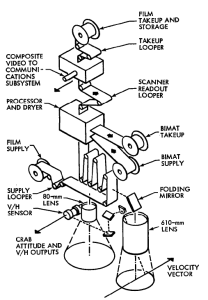
Figure 3 shows the overall process of the image capture, film processing, transmission, reception, reassembly and storage of the images:

This graphic details the film system and shows how the images are scanned from the film. Scanning is accomplished with a light beam that shines through the film an is then detected by a photomultiplier tube, (the great grandfather of the imager in your smart phone) where it was turned into a radio signal and beamed to the Earth. Upon reception at the three ground stations, (Woomera in Australia, Madrid in Spain, and Goldstone in California) the images went two directions. First, and most importantly for the LOIRP project, the images were recorded straight off the receiver to magnetic tape, shown in the lower left. The tapes were recorded in what is known as “pre-detection” format. This is the same as if you just captured a WiFi signal and stripped the waveform of the data out of it, without knowing what was in it. This form of recording has the most fidelity to the original data, and is key to the reason for having the LOIRP project in the first place.
The second path was that the image analog waveforms were demodulated and displayed to a kinescope. A kinescope is a very specific kind of display tube that displays the images on a screen in a manner similar to an old fashioned glass television tube. This is where the principal loss of dynamic range occurs as will be detailed in the next section. The images were then recorded on 35mm film. The negative for this was actually a photographic positive (because the scanned 70mm film is a negative as well). The film was then cut into strips called “framelets” which were assembled and placed under a large format camera. The resulting negative from that process was used to assemble a large format photographic print. We have many of these, which are provided as perks for the LOIRP crowdfunding. One of those is shown here in figure 4:
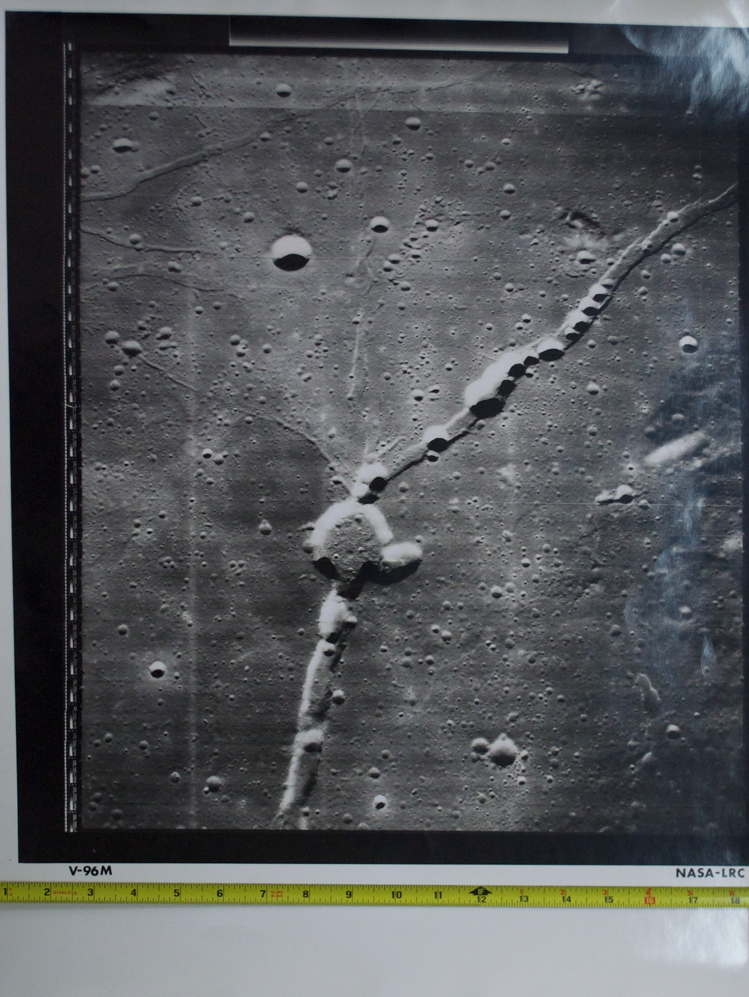
The striping comes from the framelets and how they are put together. The above is a Lunar Orbiter V medium resolution image. It is comprised of 28 framelets stitched together in the assembly process described above then processed to a large sized photographic print. It is these historic images that we are offering as the perks for the LOIRP last mile campaign. The above image is approximately 20″ x 24″ and is offered as the $250 perk. (note the images will have different locations on the Moon on them, not just what is pictured above).
Detail of the Lunar Orbiter Film Images
The images from the 70mm film on the spacecraft were processed shortly after they were taken by a dry “bi-mat” process, similar to an old polaroid camera where you took a picture, spit out the film, and then it processed it in 60 seconds and you pulled it apart. Well, except that this was super high quality (500 lines per mm ) 70mm black and white negative film. This is described in the book on the SAMOS camera, developed in the 1950’s by the U.S. Air Force, transferred to the National Reconnaissance Organization and then transferred to NASA for Lunar Orbiter.
Figure 5 shows the detail regarding the film format, and size of each image in kilometers, assuming a 45 kilometer lunar perigee orbit for the high resolution and medium resolution images:
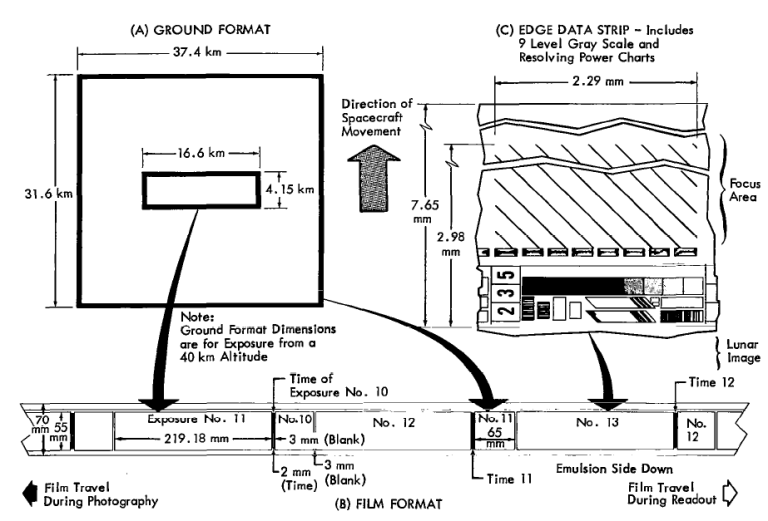
The upper right part of figure 5 is of supreme importance to our project. NASA wanted to be able to guarantee that after the image was scanned, it could be properly reassembled. Also, they wanted to be able to do a quality check on the images. The upper right has what is called “edge data.” This edge data was a part of the film that was preexposed on the Earth to produce a set of test patterns as well as a counter so that NASA would know how to reassemble the film. An explanation of the patterns in the edge data strip, along with one captured by our team during our early test digitization process is shown in figure 6:
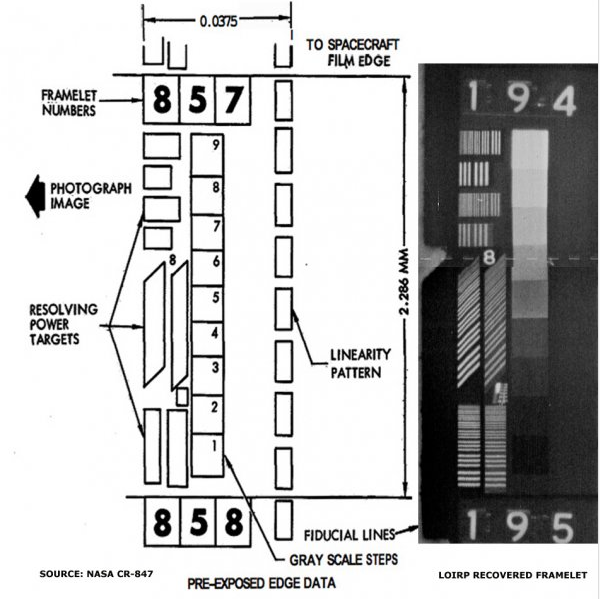
Figure 6 is an optical industry standard chart for determining the quality of a photographic image. The linearity pattern allows for accurate reconstruction of the size of the individual strips of image as they are scanned. The right side of figure 4 is from our LOIRP digitization, to show the quality of our captured images. The resolution charts are just that, they tell you the resolution of the images. The accurate reconstruction of the edge data provides verification that the scanned and transmitted image has been properly reconstructed and that the image of the Moon is in focus and meets resolution requirements.
The key for the LOIRP project is the gray scale step chart. This gray scale chart is in ten steps, which then gives a measure of the dynamic range of the image. Dynamic range is the same as how many bits you have. On board the spacecraft, the SO-243 film as a dynamic range of ~1000 to 1. in computer terms this is equivalent to 10 bits. Some images will not have this dynamic range due to the uniform nature of the lunar surface. It is most important where there is shadowing and indirect light, which was required for many images in order to determine surface slope angles and small crater depths. The Lunar Orbiter images were key to finding the landing sites for the early Apollo missions and for other science related work on the ground. Following describes some of the research done with the images.
Use of the Lunar Orbiter Images in the 1960’s to 1990’s
Since there was only a limited amount of film that could be placed on the spacecraft, NASA had to send five of them to the Moon in order to accomplish all of their mission requirements. The principle requirement was to map the moon at high resolution in the equatorial region, which is where the first Apollo missions landed. Figure 7 shows the principal areas that were imaged:
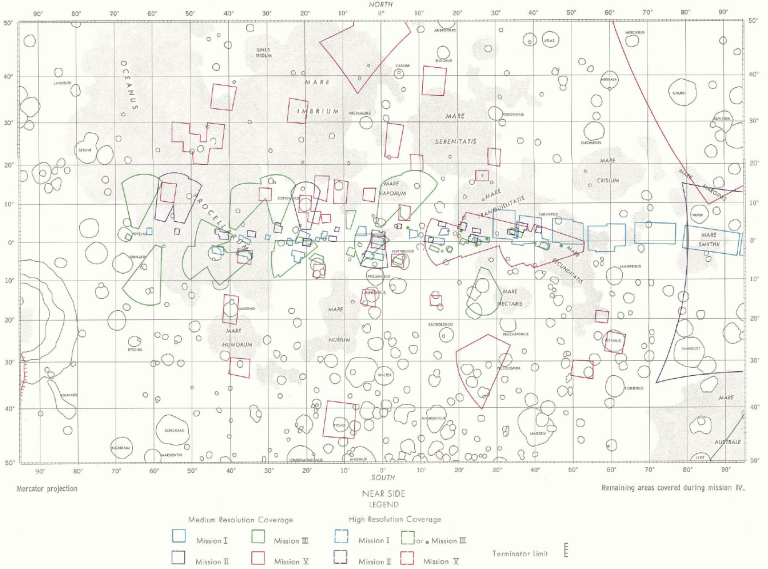
Some of the odd shaped areas are from oblique images taken by the spacecraft when it was tilted. The high resolution images were used to determine the number of small craters, the slope angles of the surface (flat or mountainous regions) and the number of rocks. Before these images, no one in all of human history knew what the surface of the Moon looked like in detail over large areas. The highest resolution images were taken in the equatorial region because that is where the Apollo missions were going to land crews: Figure 8 is one of our LOIRP images that is blown up to show the Apollo 14 landing site, along with an inset of a picture taken on the surface:
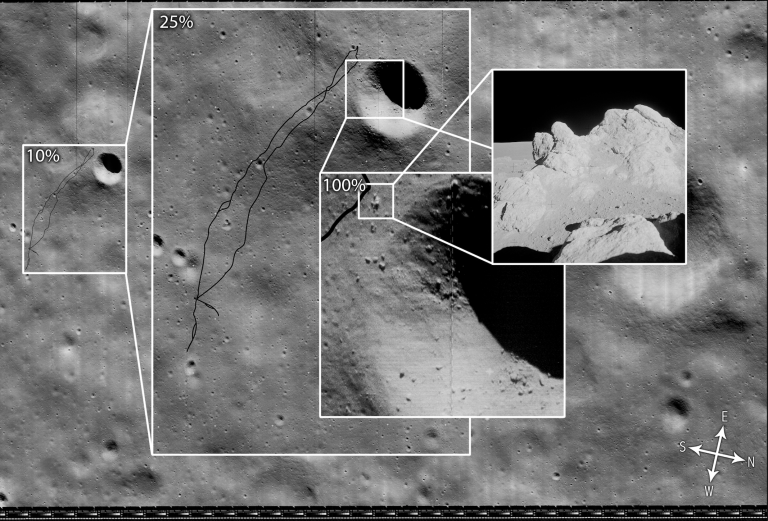
After the site selection for Apollo 11, 12, and 14, the Apollo Service Module SIM bay camera images were used to pick the sites for Apollo 15-17. The Lunar Orbiter images were the sole source for decades (until the Clementine Mission by the Strategic Defense Initiative Organization). Even with missions by other nations, the resolution of the lunar orbiter images were not exceeded until the Lunar Reconnaissance Orbiter (LRO) mission by NASA that is in orbit today around the Moon (2014).
In 1965 a memo was sent by Charlie Byrne (who has worked with us on the LOIRP project) regarding the justification for the purchase of the tape recorders and the value of the tapes. This memo, linked here, gives four principle reasons for the creation of the tapes:
- No new hardware be developed to rapidly convert the data to digital form for computer analysis.
- Predetection tape recorded data is free from degradation by the ground detection and ground photographic recording equipment.
- The tape may be replayed through the ground recording equipment with parameters optimized for particular condition of the data.
- Tape recorded data is useful in end-to-end calibration of the system.
The Lunar Orbiter tapes were used in the 1960’s for computer digitization. The largest supercomputer in the world at the time was a Univac 1170, with 256 kilobytes of RAM. NASA ran the tapes in a very similar manner to the LOIRP project, but with the much more primitive digitizer chips of the era. They did this to run computer analyses of the images to determine the height of rocks around the potential landing sites. They also used computer programs (project slope no less) to determine the slope of the surface for the potential landing sites. No rocks larger than a meter could be tolerated due to potential damage to the Lunar lander legs. Also, there was an Apollo mission requirement that no slope angle be greater than 14 degrees or the Lunar lander could tip over on landing. Both of these analyses required the tape data for maximum fidelity.
Beyond its value to the Apollo human exploration program, the science that has been done with Lunar Orbiter images runs into the several hundred peer reviewed papers. Lunar Orbiters I,II, and III were in the low inclination orbits best suited for the photo reconnaissance task for the Apollo missions. Lunar Orbiter IV and V were in polar orbits. Lunar Orbiter IV was in a 2,706 x 6,111 km orbit, giving high resolution images at 40-140 resolution and medium resolution images at 200-1000 meters. Lunar Orbiter V’s orbit was 194.5 x 6,023 km, providing images with 2 meters best resolution on the near side of the Moon. The Moon was the first body in the solar system completely mapped (98%). Even the Earth was not completely mapped from space until the Landsat era of the 1970s.
Film Scans of Lunar Orbiter Images and Other Associated Data
The best site on the Internet for lunar orbiter images has always been the Lunar and Planetary Laboratory in Houston (http://www.lpi.usra.edu/resources/lunarorbiter/). That is the go to site that I use almost every day when looking at comparable lunar images when doing work on LOIRP. Another good site, though only for Lunar Orbiter’s 3, 4, and 5 is the Planetary Data Node at the U.S. Geological Survey in Flagstaff. However, at both sites, all of these images are from scans of the film (called the GRE film for Ground Reconstruction Electronics) described above related to figure 3.[1]
The U.S. Geological survey scanned the film with an 8 bit scanner, providing a dynamic range of 255 to one. This is consistent with what we know of the dynamic range of the GRE film. However, as stated above, the 70mm SO-243 film on board the spacecraft had a 1000 to 1 or ten bit dynamic range. This is shown in figure 9, which describes the film density of the gray scale chart shown in figure 6:

The charts above were what I first ran into in the late 1980’s after obtaining a set of Lunar Orbiter microfilm prints and this is what led to my interest in recovering the original images from the tape. If you look to the top right where it calls out the film density from the Gray Step chart, you will see the legend “Reassembled Record Density Change“. This is the reproduced density of the GRE film which correlates to the Grays in the step chart seen in figure 6 right. Thus it can be determined that Gray Step 1, possibly 2, and 8, as well as step 9 are clipped, or eliminated in the GRE film that was used by the USGS and everyone else after the use of the Lunar Orbiter tapes ended during the Apollo era. This effectively clipped the data from 10 bits to 8 bits. This is a compression of the dynamic range by a factor of four. Also, the lower graph, with an overlay of video from an oscilloscope, is a single line scanned across the Gray Step chart, showing that the video signal matched the transfer function of the SO-243 film. Interestingly, we could optimize this transfer function in either electronically in the demodulator or in software in post processing.
In the late 1980’s before I was a college student, I was an engineer in a television studio that used tape drives similar to the ones used for the Lunar Orbiter tapes. When I did my research during my college years studying the moon, I found that the tapes did indeed exist and that someone was trying to digitize the images. However, years later I found out that this had not been the case, thus the LOIRP project was born.
LOIRP
Rather than regurgitate extensively the history of the LOIRP project (please see the links at the end of this article for documentaries and papers and posters that we have done), I will summarize and then describe why we are asking for the public’s hard earned money to complete the project.
When we started the project, we had three fundamental questions to answer:
1. Can 40+ year old Ampex FR-900 Instrumentation Tape Drives be brought back to an operating condition?
2. Is there any data on the tapes?
3. If there is data on the tapes, is it of higher quality than what is available in the existing archives.
We definitively answered all three questions in the affirmative in our previous efforts and as described in this missive and in the referenced paper.[2] Visually, the difference in dynamic range can be immediately apparent, especially in images with a lot of light and dark (which corresponds to a wide dynamic range).
In November of 2008, after six months of work we reintroduced Lunar Orbiter to the world. Figure 10 is an example of the improvement in a Lunar Orbiter 1 famous image, which is the first Image of the Earth, taken from around the Moon:
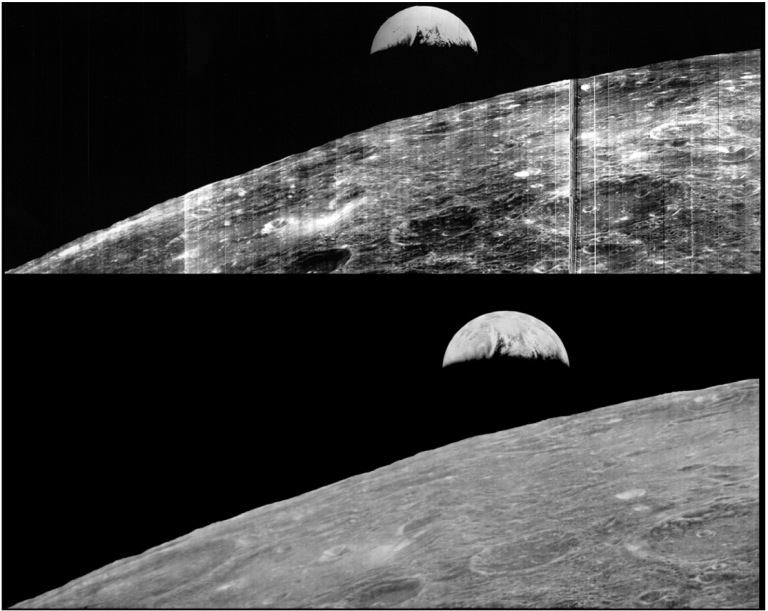
Digital capture of the original analog tape at the individual scan line level and at the full dynamic range of the 70mm film allows us to recover far more of the original data than from other sources. We were even able (with an artist’s help) above to remove the bimat dryout line to the right of the earth. Figure 11 is a blow up of the earth, impossible to obtain from the film:
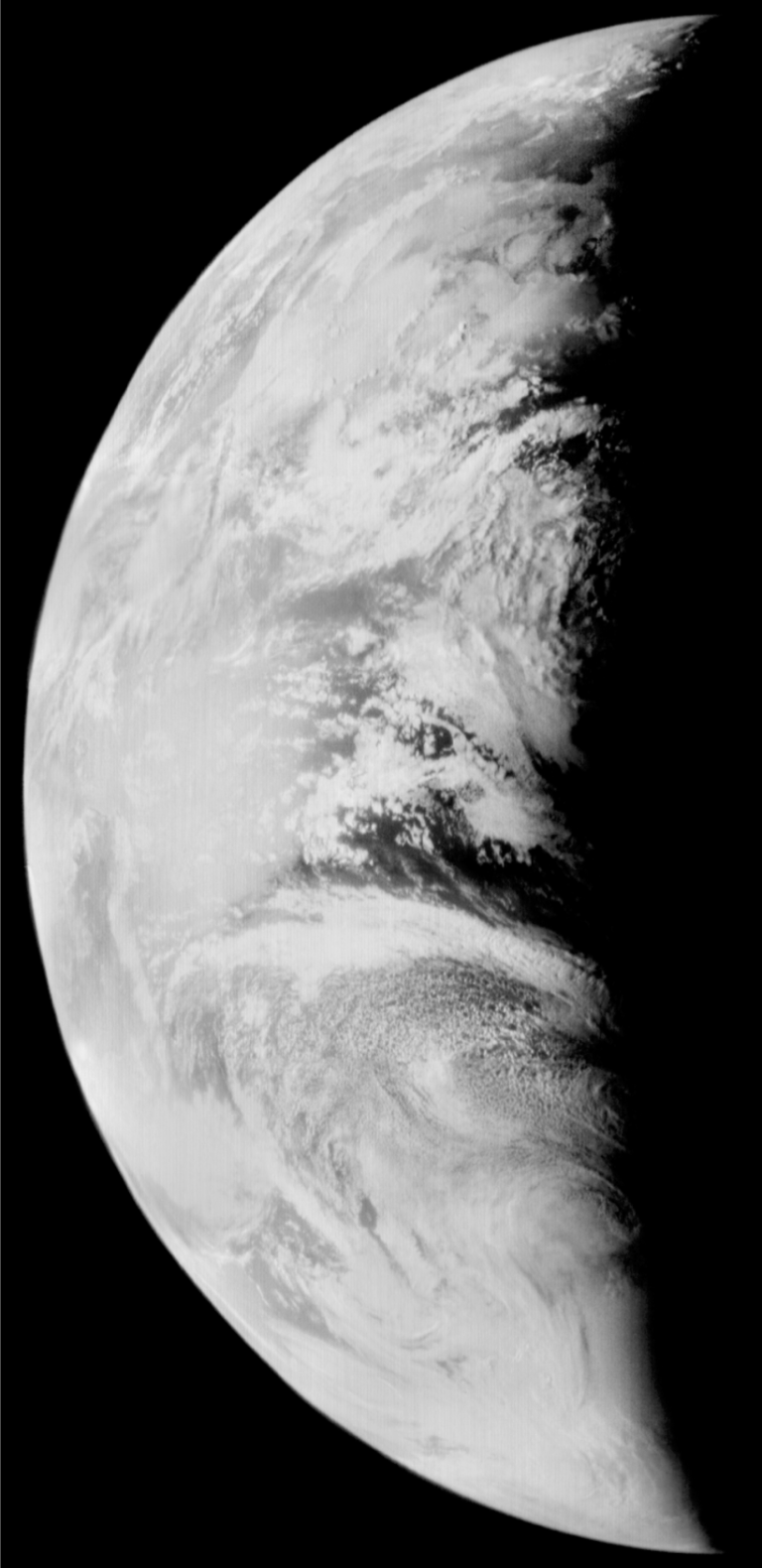
For artistic purposes NASA flipped this over on its side, but here we reproduce it in its proper orientation. You can see the north coast of Africa, the Mediterranean sea, and Sicily and Spain in the upper part of the image. You can also see the coast of South America to the far left, with a fog bank hugging the coast. At the bottom you can see the Antarctic ice pack at that date, August 23, 1966. The cloud formations are clearly visible, down to about what we estimate is a five kilometer resolution. You can even see the sun glinting off the the Atlantic ocean, something that exoplanet hunters have talked about using as a means to detect oceans on exoplanets. This is with what would today be a very modest telescope. Figure 12 also shows the effect of improved dynamic range in a high contrast oblique image of the Lunar surface:
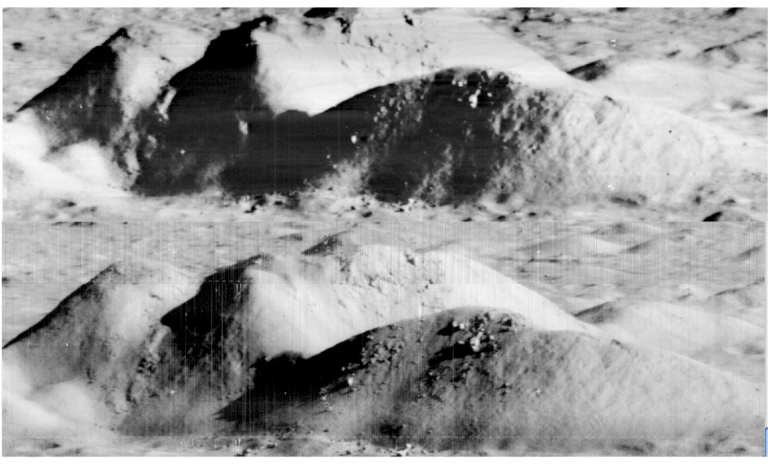
These are good details from images. However, we have a poster from a NASA conference that we call our money chart. The full sized chart is linked here, but a reduced version of that is shown here in figure 13:
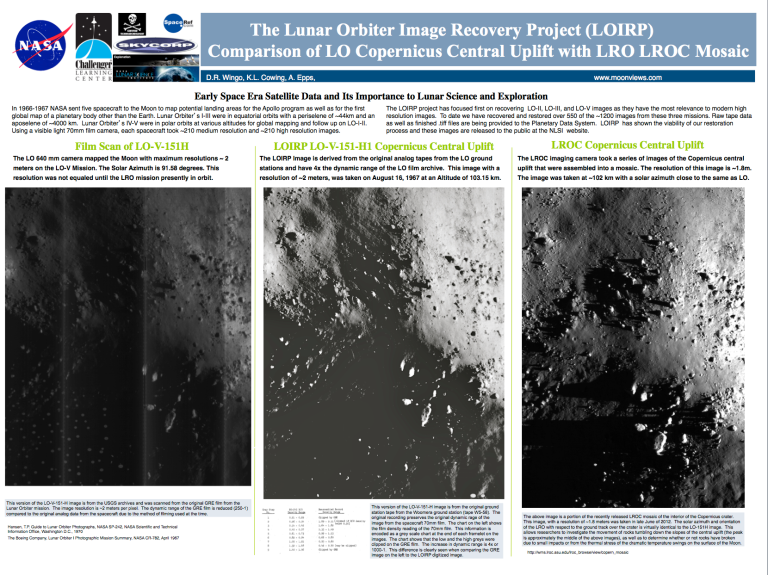
Please download the chart at the link to get the full feel but it can easily be see how the improved dynamic range and our ability to easily do software processing to remove the striping artifacts makes the Lunar Orbiter image fully comparable to the current Lunar Reconnaissance Orbiter’s (LRO) LROC camera image of the same area under similar lighting conditions. Thus we establish the value of our work for using the digitized Lunar Orbiter images from tape as a scientific baseline from the 1960’s fully comparable to any future work at this high resolution. No other spacecraft from the 1960’s until the LRO mission achieved this level of resolution of the lunar surface.
Where We Are Today
We have been very fortunate to get as far as we have. Our original NASA sponsored work was to digitize Lunar Orbiter II and III as a compliment to the work of the USGS. Lunar Orbiter I only has a few high resolution images as a result of the failure of the image motion compensation system. However, in 2013, thanks to an earlier crowd funded effort, NASA gained confidence that we could complete the digitization of all of the Lunar Orbiter images. We were also fortunate to have one of the Ampex old engineers (Ken Zin and Al Sturm) and all of his friends and associates who knew how to put the tape drives together. We have also have had exceptional support from NASA Ames, headquarters, and the science community. For us the LOIRP project has been a labor of love for the community for which we are a part, and to provide them to the public, that paid for them.
In late 2013 we completed the scan of all the images on the 1478 tapes in our possession. We were able to recover more than 98% of the images on the tapes, a remarkable testimony to the engineers of the 1960’s and their care for the tapes. Figure 14 shows how the images were scanned from the 70mm film and how we saw them during our playback of the tapes:

If you look above on figure 14 you will see that the light beam (reference above in figure 3), scanned through the film, producing a change in current in the photomultiplier tube. This is what you see in the individual line near the bottom of figure 12: Other components are superimposed on the line, such as the synchronization pulse (vertical sync pulse for those in the television field). An additional “spike” near the beginning and end of each line is also added. This is the “stitching” that can be seen when you blow an unprocessed Lunar Orbiter image up (you can see the stitching on the right side of figure 6 in the middle of the calibration section running horizontally). The reason for the stitching is to aid in the reassembly of the image. There is a tiny (0.05″) overlap between the framelets (which is what one scan across the film as seen to the left and middle top is defined as). This overlap was theoretically back then to allow a machine to reassemble the images for further processing. The overlap is ideally eliminated in post processing of the digital images. Figure 15 shows in summary how we do our work:

This process was originally manual, but with our engineer Austin Epps and software from Lunar Orbiter veteran Charlie Byrne (the same one from the 1965 memo), we have been able to automate this process.
What the Crowd Funding Will Pay to Do
We are over 90% of the way through our total process. All of the tapes have been captured. We are about to donate the refurbished tape drives and the demodulator to the Library of Congress. The Library is the repository of the knowledge of the American people and we feel that this is the best long term home for the tape drives.
The tasks that we have to finished and still have to do are as follows.
- Tape Capture
The tape capture of all of the tapes and all of our Lunar Orbiter Images is complete.
2. Framelet Slicing
This is where all of the framelets, captured on the tapes, are “sliced” or separated into individual files. This task is also completed.
3. Framelet File Naming
This task takes the approximately 107,000 framelet files and names them with the proper lunar orbiter and image and framelet number. Approximately 97,000 of these are done and about 10,000 to go. This is the major task to be completed that will allow us to fill in the data that is needed for most of the submittal to the planetary data system.
4. Framelet Image Processing
This task is to take and run a batch program that takes the framelets and runs an image processing program on them to remove the “W” pattern, which is an artifact from the scanning of the 70mm film on the spacecraft. This basically averages the gray scaled framelets and some other minor processing. This is the first step in creating the finished .tiff large images for the SSERVI website. This is a mostly automated process but sometimes it crashes due to defects in the capture, defects on the tapes, and when this happens, which is for a certain percentage, then it has to be done manually, taking a lot of time. This task is about 40-50% complete and has to be run on all 107,000 framelet files.
5. Framelet Assembly Into Images
We have to take the processed framelets and assemble them into images. Thanks to Austin Epps scripting wizardry this is also a mostly automated process but has the same tendency to crash for a minority of files, which have to be manually done. This task is also about 40-50% complete.
6. Final Processing
The assembled images then go through a final round of image processing as a complete or mostly complete image. Some of the images are not complete from the spacecraft and some are not complete because of a defect in the tape. We have done as much as we reasonably can to capture all the framelets correctly. We have over a 98% completion rate, which is remarkable for something this old. We also have images that are not in the current NASA database at either LPI or the USGS. These will be published as well and we hope that with your support we can go ahead now and start this process. These images will show up on the NASA SSERVI website as they are completed. They are also going to the NASA Planetary Data Center for archiving and preservation. We are also at about 40-50% complete on this task.
7. Paperwork
For all of this there is a lot of paperwork. We have myself, Austin, Marco, and some students to help, but for a project of this size, this is a labor intensive task. We are developing the link between the raw images and the completed .tiff files. It is vitally important to save the raw data as image processing technology advances rapidly and it will almost certainly be the case that future researchers will improve on our work in assembling images that can be better correlated to modern images. We are also doing the submittal to the Planetary Data System (PDS) and this requires a lot of work, back and forth with a peer review committee and eventual disposition to the PDS of all of our work. This includes the public website data that we will put out there so that the public can also play with our images and know what the, as we call it in the business, the traceability is to the raw images. In science having the raw data is crucially important to establish scientific provenance.
This task is already underway now but much has to be done.
So the above tasks are what we need your generous donations for. Watch our progress even before the end of the crowd funding effort so that you know that your hard earned dollars are being well spent!
Links
NASA SSERVI
http://sservi.nasa.gov/LOIRP/loirp_gallery/
Documentaries and Interviews and Web Pages
Our Wikipedia Page
http://en.wikipedia.org/wiki/Lunar_Orbiter_Image_Recovery_Project
Documentary on LOIRP by Scott Manley of the Kerball Space Program!
https://www.youtube.com/watch?v=GBs3rd_u90QGeekbeat TVhttps://www.youtube.com/watch?v=f6pw_l9yLdACarnegie Museum of Art Short on Lunar Orbiter Image Recovery Projecthttps://vimeo.com/100736619
Digital Amnesia, a Dutch Documentary About Losing our Digital Heritage, Featuring the Lunar Orbiter Image Recovery Project.
https://www.youtube.com/watch?v=NdZxI3nFVJs
Spacevidcast interview about the LOIRP project and lunar exploration and development.
http://sservi.nasa.gov/articles/dennis-wingo-on-loirp-and-lunar-utilization/
Our Old Website
References
[1] L. Gaddis, T. Becker, L. Weller, D. Cook, J. Richie, A. Bennett, B. Redding and J. Shinaman, REVIVING LUNAR ORBITER: SCANNING, ARCHIVING, AND CARTOGRAPHIC PROCESSING AT USGS, Astrogeol- ogy Team, U.S. Geological Survey, 2255 N. Gemini Drive, Flagstaff, AZ
[2] D. R. Wingo1 and C. J. Byrne2, 1, ANALYSIS OF LUNAR ORBITER IMAGES RECOVERED FROM ANALOG TAPE Skycorp Incorporated, P.O. Box 375 Moffett Field, CA, wingod@skycorpinc.com Image Again, charles.byrne@verizon.net

Dennis, THANK YOU to you and your team for undertaking this AMAZING work. That this might not have been done and the history lost seems unbelievable. Thank you, Thank you, Thank you … !!! The quality of the final products is spectacular and it highlights the state of the art imaging capabilities that were available as far back as the image taken by Lunar Orbiter 1 of Earth from the Moon in 1966 … Truly mind boggling … !